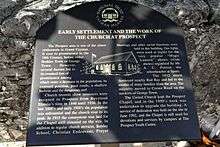Watler Cemetery

The Watler Cemetery is a historic cemetery located in Prospect, Grand Cayman. It was donated to the National Trust for the Cayman Islands by the Watler family in 1991.[1]
Although the graves in the cemetery date from the beginning of the 19th century, it is possible that the site was in use even before that, as Watlers have lived in the Cayman Islands since the 17th century, and are amongst the original settlers of Grand Cayman. It is thought that the name is derived from the "Walters" surname.[1]
Watler Cemetery is notable for the number of traditional-style grave markers which still stand within its walls. Shaped like houses, the memorials are constructed with a combination of crushed coral and limestone daub. Similar markers, dating to the Middle Ages, have been found in both England and Wales; other markers in the same style, these dating to the 17th century, may be seen across the British West Indies.[1] The markers are designed so that a wooden coffin may be safely buried underneath; the stones are heavy enough that only the most violent of storms could dislodge them. At one time each marker had a mahogany tablet set into one wall, listing the name and dates of the deceased; many of those have disappeared over the years, while others have become illegible. More modern stones cover numerous burials, but traditional markers were designed for only one body each.[1]
The cemetery is today enclosed by an old stone wall; the original entrance is now filled in, but may be seen almost directly across from the current one. Mature trees surround the graveyard and the Prospect Youth Centre is located on the eastern side of the cemetery. The centre is run by the United Church.
Today, the cemetery is almost all that remains of Prospect.
Cemetery markers
The National Trust of the Cayman Islands placed several plaques in the Watler Cemetery. The plaques are described below:
The Watler Cemetery – a typical family cemetery

"It was the custom of early settlers to set aside a portion of their land for a family graveyard. Favoured locations were ofter on the sea coast where the ground was sandy and it was easy to dig the graves. The Watler Cemetery is a good example of a typical family graveyard. The graves in this cemetery date from the early 19th Century but it is believed that it was in use for a considerable period before that. According to Hirst's Notes on the History of the Cayman Islands, many of the pioneers of Brisith occupation were buried at Prospect. The Watlers were amongst the earliest settlers in Grand Cayman and it is believed that the first Watler may have been a deserter from Cromwell's army. The surname "Watler" is thought to have been originally "Walters" and of Welsh origin. This small family cemetery was donated to the National Trust by the Watler family in 1991.
House-shaped graves

In this graveyard many of the graves are marked by house-shaped gravemarkers. Toms of this nature may owe their origin to similar graves found in Medieval England and the British West Indies from the 1600s onward. In Cayman, the body was not contained in the actual tomb which was made of limestone daub but was buried in a coffin in the sand beneath. An unusual feature of these was the hardwood marker attached to each one, bearing the name and other information about the deceased. It is probable that hardwood headmarkers were used instead of inscribing in the stone, as the early settlers were carpenters and shipbuilders rather than stonemasons.
Early settlement and the work of the church at Prospect

The Prospect area is one of the oldest settlements in Grand Cayman. It rose to prominence in the 18th Century, before either Bodden Town or George Town. However, several factors lead to its eventual loss of prominence among which were: a decrease in the population, its exposed position, poor roads, a shallow harbour and the dangerous reef. Church records show ministers were assigned to Prospect from Reverend Elmsie's time in 1846 until 1936. In the late 1800s and early 1900s the population was substantial and the church rose to its peak. In 1915 the cornerstone was laid for the Chapel still situated on the site. In addition to regular church services, Sunday School, Christian Endeavour, Prayer Meetings and other social functions were held in this building. Gas lights were used at nights for the very popular "Magic Lantern" shows (slide shows) organized by Mr. A. C. Panton the schoolteacher at Spotts. The 1932 storm destroyed nearby Red Bay and led to the exodus of many families from the area. The majority moved to Crewe Road on the outskirts of George Town. The United Church kept the Prospect Chapel, and in the 1990s work was undertaken to upgrade the building. A service of dedication was held on the site in June 1992, and the Chapel is still used for devotions and services by campers at the Prospect Youth Centre.
Notes and references
External links
![]() Media related to Watler Cemetery at Wikimedia Commons
Media related to Watler Cemetery at Wikimedia Commons
Coordinates: 19°16′26″N 81°20′06″W / 19.274°N 81.335°W